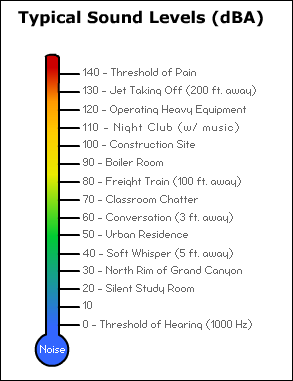Preventing Hearing Damage From Occupational Noise Exposure

Noise is one of the most common causes of hearing loss, and one of the most common occupational illnesses in the United States. Twenty-two million workers are exposed to potentially damaging noise at work each year. Over the last 20 years, government agencies have consistently identified Noise-Induced Hearing Loss (NIHL) as one of the top concerns of workers.
According to the National Institute on Deafness and Other Communication Disorders (NIDCD):
- 10 million Americans have already suffered irreversible hearing damage from noise.
- 30 to 50 million more are exposed to dangerous noise levels each day.
What are the warning signs that your workplace may be too noisy?
Noise may be a problem in your workplace if:
- You hear ringing or humming in your ears when you leave work.
- You have to shout to be heard by a coworker an arm’s length away.
- You experience temporary hearing loss when leaving work.
 How loud is too loud?
How loud is too loud?
The National Institute for Occupational Safety and Health (NIOSH) has recommended that all worker exposures to noise should be controlled below a level equivalent to 85 dBA for eight hours to minimize occupational noise induced hearing loss.
Try out this Noise Meter here for reference.
What damage can loud noise do to your health?
NIHL is a hearing disorder characterized by a gradual, progressive loss of high frequency hearing sensitivity over time, as a result of exposure to excessive noise levels. Neither surgery nor a hearing aid can help correct this type of hearing loss. Noise-induced hearing loss is a particularly insidious condition, since it occurs virtually unnoticed by the affected individuals. They feel no pain and initially can communicate easily because hearing loss begins at higher frequencies around 4,000 Hz and the damage takes place gradually.
Acoustic Shock
In addition to long-term hearing loss, another risk is acoustic shock. Acoustic shock disorder (ASD) is an involuntary response to a sound perceived as traumatic (usually a sudden, unexpected loud sound heard near the ear), which causes a specific and consistent pattern of neurophysiological and psychological symptoms. These include aural painfulness, hyperacusis, muffled hearing, vertigo and other unusual symptoms such as numbness or burning sensations around the ear.
Tinnitus
Another condition that is often part of NIHL is tinnitus, a condition described as the perception of sound (often buzzing, ringing, or hissing) in the absence of any external stimulus (that is, there is no sound others hear but the tinnitus sufferer does). This essentially takes away the opportunity for the person to experience quiet, and can be very distressing. About 30 million adults suffer from persistent tinnitus.
Some of the warning signs of the presence of, or exposure to, hazardous levels of noise are:
- You can’t hear someone talking three feet away
- You have a feeling of “fullness” in your ears after leaving a noisy area
- You hear ringing or buzzing (tinnitus) in your ears immediately after exposure to noise
- You suddenly have difficulty understanding speech after exposure to noise; you can hear people talking but you have difficulty understanding them.
Loud noise can also:
- Create physical and psychological stress
- Reduce productivity
- Interfere with communication and concentration
- Contribute to workplace accidents and injuries by making it difficult to hear warning signals.
How much does hearing damage cost companies?
Last year, U.S. business paid more than $1.5 million in penalties for not protecting workers from noise. While it’s impossible to put a number to the human toll of hearing loss, an estimated $242 million is spent annually on workers’ compensation for hearing loss disability.
Preventing noise-induced hearing loss
One-third of permanent hearing loss is preventable with proper hearing loss prevention strategies. To protect yourself when exposed to hazardous noise, you should take these precautions:
- The first line of defense against occupational noise is to diminish loud sounds at their source, wherever possible. Such methods are called engineering controls and involve measures such as installing “silencers” such as mufflers and baffles on equipment.
- Wear hearing protection devices (HPDs) such as earplugs or earmuffs, when involved in loud activities. When properly selected, and used, HPDs can be powerful tools for preventing NIHL. HPDs are required by law to be labeled with a Noise Reduction Rating (NRR) that is based on performance obtained under ideal laboratory conditions. There is no single protector that will fit everyone, be universally comfortable, and be appropriate in every environment so it’s best to do some research.
- Both employers and workers must be educated about the importance of good hearing and avoiding NIHL. While this may seem self-evident, many people hold common misconceptions about hearing loss and proper education and training is needed.
Hearing loss prevention is critical in the workplace and needs to be addressed accordingly. For assistance on implementing safe noise regulations, contact Jim DePew below.
Jim DePew
Vice President & Consultant
Mobile: (330) 631-9022
Office: (330) 915-2355 Ext: 103
Email: jdepew@bdewees.com
